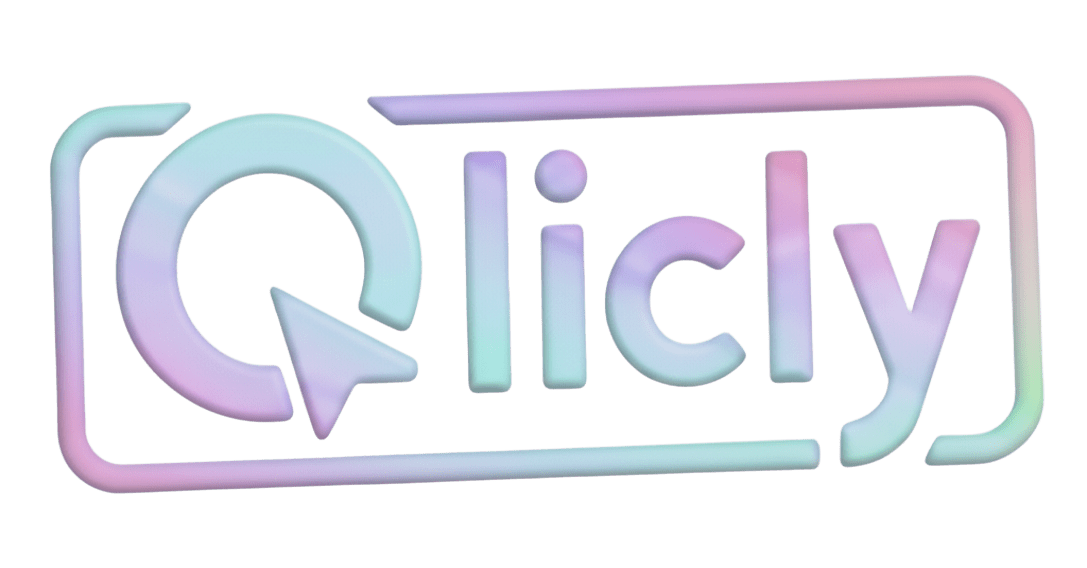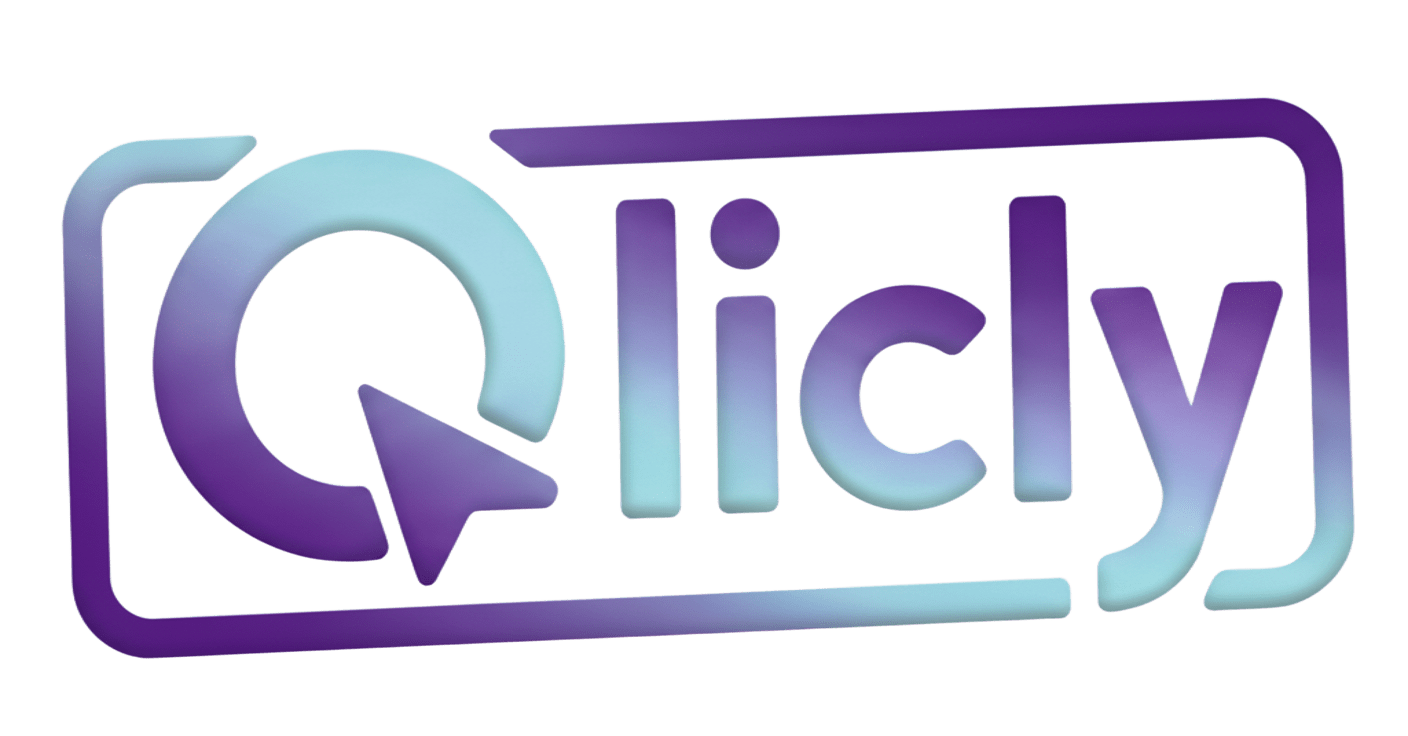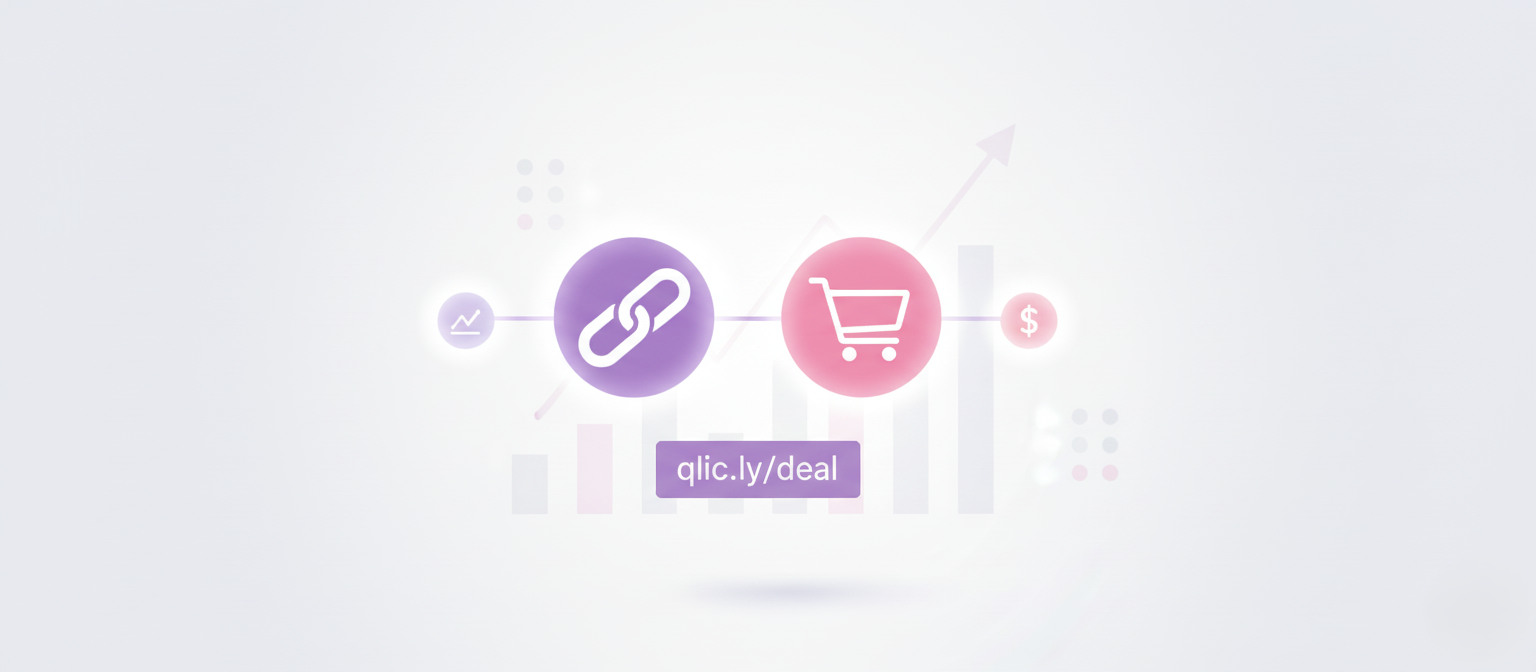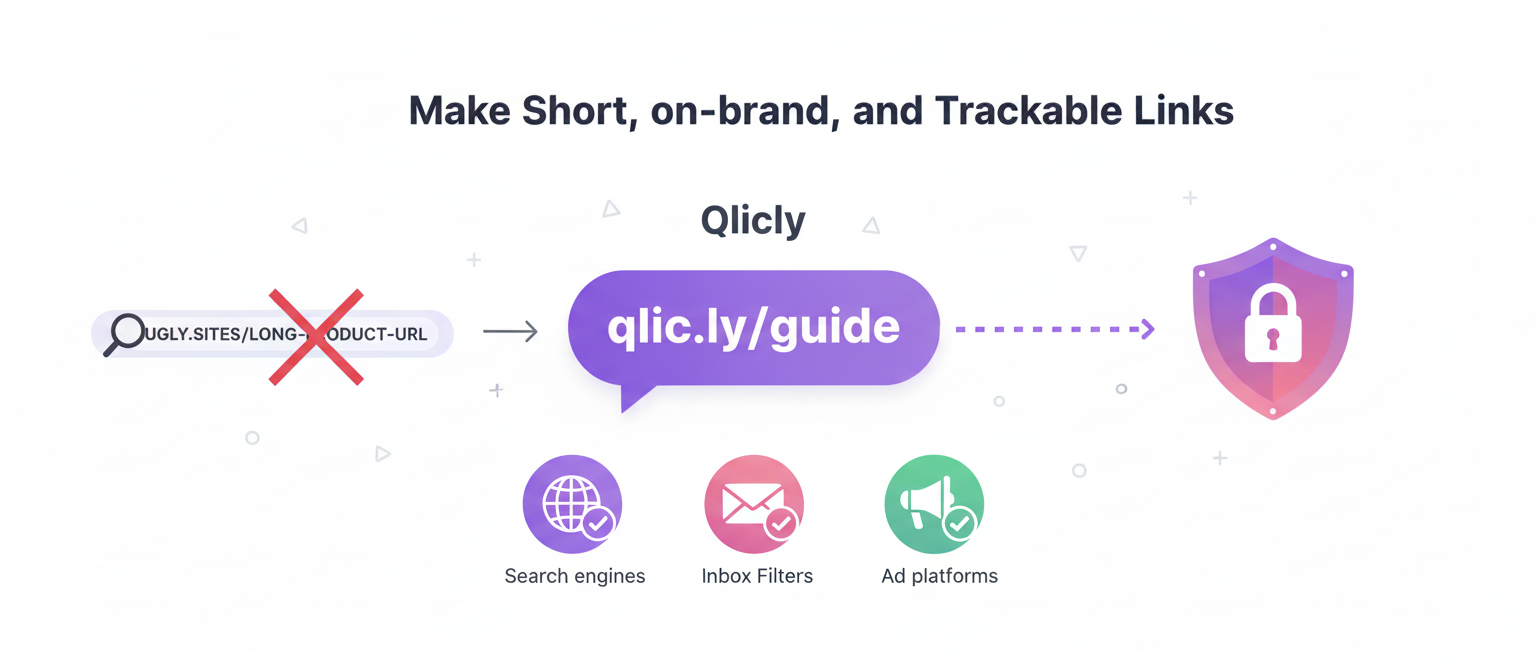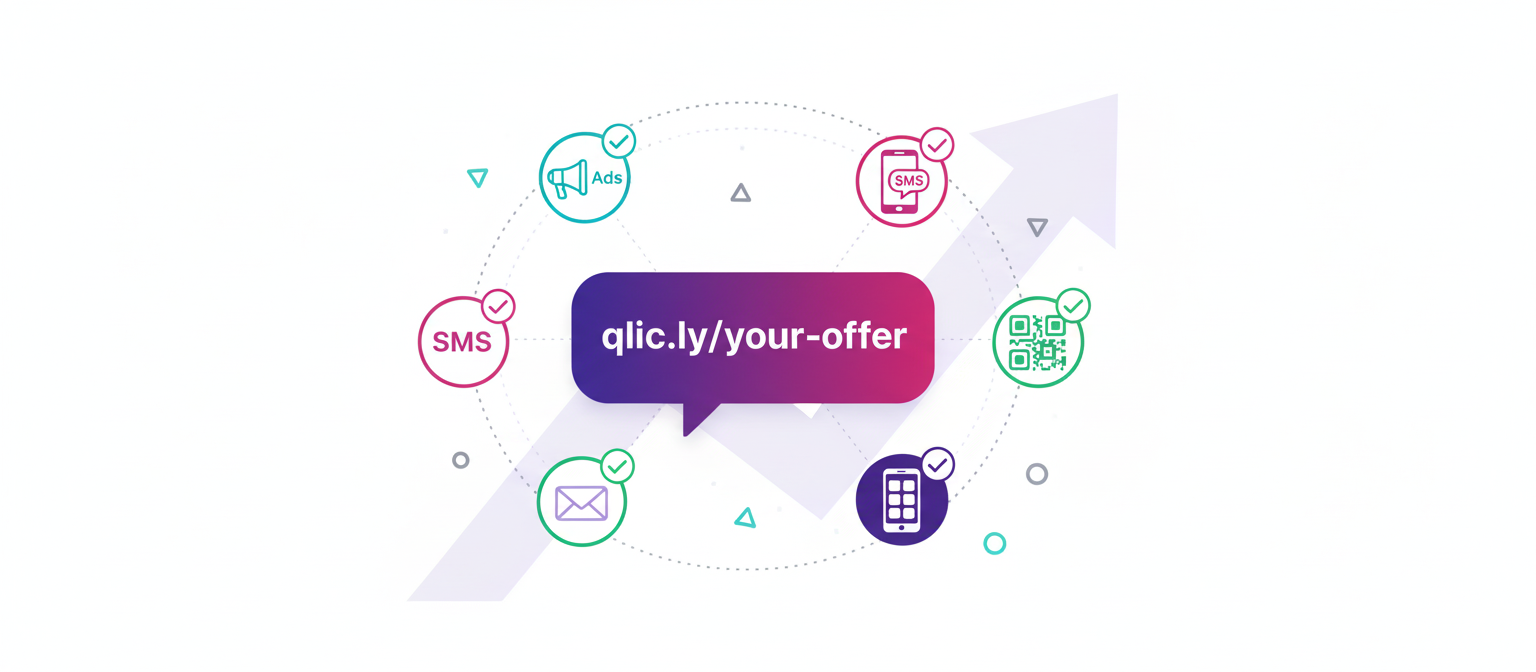
How to Sell Branded Short Domains to Businesses: A Playbook Backed by Data
If your prospects still share links like bit.ly/abc123, they’re leaking trust, clicks, and deliverability. Branded short domains (BSDs) — think qlic.ly/sale — put the company’s name directly in the link, increasing recognition and reducing friction. Multiple datasets show BSDs can lift click-through rates (CTR) and improve SMS/email acceptance when compared with public shorteners [1][2][7]. This guide gives you a practical, data-backed sales playbook you can use today.
We’ll cover: what BSDs are, why they work, who to target, a ready-to-run sales motion with ROI math, packaging ideas, a step-by-step implementation plan using Qlicly, and objection handling — complete with scripts and examples like qlic.ly/launch, qlic.ly/app, and qlic.ly/press.
TL;DR
- BSDs lift CTR: Bitly found up to 34% higher CTR vs. unbranded links; Rebrandly observed improvements up to 39% [1][2].
- Deliverability matters: Carriers and providers increasingly distrust public shorteners in SMS; branded domains are less likely to be filtered [6][7][16].
- Privacy-resilient measurement: Apple’s Link Tracking Protection strips many tracking parameters in iOS/macOS; first-party short links preserve click analytics [8].
- Sell outcomes, not links: Use a simple CTR-uplift ROI model, run a 14-day pilot, and close on business impact — not features.
- Qlicly-ready: Connect a domain, create human-readable slugs, enable deep links/QRs, and track performance from one dashboard [15][16].
What Is a Branded Short Domain?
A branded short domain is a concise, memorable domain controlled by the business that’s used to shorten and route links — for example, es.pn (ESPN), nyti.ms (The New York Times), amzn.to (Amazon), and youtu.be (YouTube) [9][10][15]. With Qlicly, you can attach your own domain and create on-brand short links such as qlic.ly/sale or go.brand/spring, then analyze performance across channels [16].
Why Businesses Buy Them: Measurable Benefits
1) Higher CTR & Trust
BSDs put brand identity in the hostname — a strong trust cue that reduces hesitation. In a case study, Bitly reported that “Branded Short Domains drive up to a 34% increase in CTR when compared to unbranded links.” [1] Rebrandly’s controlled experiments similarly found branded links received up to 39% more clicks than generic short URLs [2]. When your sales conversation centers on measurable CTR lift, the value becomes tangible.
2) Better SMS Deliverability & Compliance
In A2P SMS, public shorteners are common spam vectors. Messaging providers and carrier-aligned guidance caution against generic/shared shorteners; branded domains are recommended to reduce filtering risk [6][7][16]. Twilio’s documentation also supports shortening with your company-branded domain, with click tracking built in [3][14]. If your buyer runs SMS at scale, this argument alone can justify the switch.
3) Privacy-Resilient Measurement (Post iOS 17)
Apple’s Link Tracking Protection automatically removes known tracking parameters from links in Mail, Messages, and Safari’s Private Browsing. Your links still work, but granular UTMs can disappear in those contexts [8]. A BSD with first-party click analytics keeps your top-level measurement intact (click counts, referrers, devices), so you retain campaign signal even when parameters are stripped.
4) Governance & Security
Public shorteners are routinely abused in phishing, precisely because they hide destinations. Research and industry reports document shortened-URL misuse by attackers [11][13]. Owning a BSD improves governance: you decide who can create links, you can revoke or retarget, and you minimize reputational spillover from shared domains.
5) Brand Consistency Everywhere
BSDs make links human-readable and memorable across ads, social, email, SMS, podcasts, print, and QR codes. Consistency compounds recognition — and recognition drives clicks. For an overview of how short links unify cross-channel campaigns, see Qlicly’s guides on short links in digital marketing and BSD benefits [15].
Who to Target (and How to Qualify Quickly)
- Ecommerce/Retail: Frequent promos in email/SMS/social; heavy reliance on QR in packaging and stores.
- SaaS & Apps: Deep links to app content (qlic.ly/app) and onboarding flows; product-led growth.
- Media & Publishers: High-velocity link sharing; strong fit for vanity domains (e.g., nyti.ms) [10].
- Agencies: Multi-brand management and reporting; governance and naming standards matter.
- Franchises & Multi-location: Localized slugs (e.g., qlic.ly/miami-lunch) and QR for offline.
Fast qualification questions: “Do you send SMS at scale?” [6][7][16] “What’s your average CTR by channel?” “Are UTMs being stripped in certain contexts?” [8] “Who owns link governance today?” If they struggle to answer, there’s an immediate opportunity.
Sales Playbook: From Discovery to Signed Contract
- Discovery: Map channels, volumes, current CTR, and deliverability pain. Capture three sample links to compare (ad, email, SMS).
- Demo: Show a live BSD link — e.g.,
qlic.ly/launch— and how to create slugs, deep link to apps, and generate QR codes in Qlicly [16]. - ROI model: Use CTR-uplift ranges from the literature (conservative 10–20%, typical 20–30%, upside 34–39%) [1][2].
- 14-day pilot: A/B the same creative with (A) public shortener vs (B) BSD. Hold creative, audience, and timing constant.
- Business case & close: Convert incremental clicks to revenue/conversions, include SMS acceptance improvements if applicable, then present a payback timeline.
ROI Math Example (Keep It This Simple)
Assume 1,000,000 impressions at 2.0% CTR = 20,000 clicks. With a 30% CTR uplift from BSD, CTR becomes 2.6% = 26,000 clicks. Incremental clicks: 6,000. At a 3% conversion rate, that’s 180 additional conversions. With $60 AOV, that’s $10,800 incremental revenue. This excludes potential SMS deliverability gains and brand-trust lift downstream.
Packaging & Pricing Suggestions
- Starter: 1 branded domain, 10k monthly clicks, 3 users, QR codes, link analytics.
- Growth: 3 domains, 100k monthly clicks, deep linking, A/B destination tests, campaigns/channels reporting.
- Scale/Enterprise: Unlimited domains, SSO, audit logs, SLAs, API automation, advanced permissions.
- Add-ons: Dedicated onboarding, custom reporting, migration support from public shorteners, agency workspaces.
Implementation Guide (Qlicly)
- Choose the domain: Keep it short, pronounceable, and tied to your brand (e.g., go.brand, brand.co, or a tasteful TLD hack). If using a country-code TLD (ccTLD), review registry rules and risk; ccTLD policies vary by country [10].
- Connect it in Qlicly: Add a CNAME per platform instructions, enable HTTPS, and verify ownership. Twilio and others also document branded link setups for messaging [3][14][16].
- Harden for deliverability: In email, align your tracking/redirect domain with your authenticated sending identity and follow Gmail/Yahoo bulk sender guidance (SPF, DKIM, DMARC) [4][5].
- Standardize slugs & tags: Use human-readable slugs and consistent UTM/tagging conventions for clean reporting (e.g.,
qlic.ly/webinar-invite,qlic.ly/press). - Instrument & automate: Use Qlicly analytics and API to create links at scale, rotate destinations, and push events to your stack [15][16].
Migrating from a Public Shortener (Without Losing Data)
- Inventory: Export current links; prioritize by traffic and revenue impact.
- Recreate priority links: Build them on your BSD with readable slugs.
- Redirects: Where you control the source, use 301 (permanent) redirects for lasting changes; reserve 302 (temporary) for tests/seasonal campaigns [17][18].
- Swap in templates: Update ESP/SMS templates, ad macros, and social schedulers to the BSD.
- Monitor: Compare CTR, conversions, block/complaint rates, and link health during the first 2–4 weeks.
Objection Handling (Scripts You Can Adapt)
- “We already use bit.ly and it’s fine.” “Totally — and we’re not removing link shortening; we’re upgrading to your own domain. Independent studies show branded domains drive higher CTR (up to 34–39%). Plus, carriers increasingly filter public shorteners in SMS; your brand domain helps avoid that” [1][2][6][7][16].
- “Will this break tracking?” “No. It preserves click analytics and helps when Apple strips some tracking parameters in Mail/Messages — your link still logs the click even if UTMs are removed in those contexts” [8].
- “Security/compliance?” “You control creation, permissions, and destinations. Public shorteners are widely abused in phishing; owning the domain reduces collateral risk and improves governance” [11][13].
- “Too much effort.” “Setup is a CNAME + verification. We can run a 14-day pilot on a single campaign; if CTR lift covers the license, we roll out. Low lift, high signal.”
KPIs to Report (and Win Renewals)
- Top-line: CTR by channel/campaign; incremental clicks vs. baseline.
- Downstream: Conversion rate, revenue per click (RPC), lead quality.
- Deliverability: SMS acceptance/error codes; email inbox placement, complaints, and unsubscribes [4][5][6][7].
- Governance: Link sprawl reduction, % readable slugs, redirect hops per link.
14-day pilot plan (send after discovery)
- Pick one campaign in [channel].
- Create two otherwise-identical variants: A = public shortener; B = BSD.
- Run to significance; measure CTR, conversions, and deliverability error codes.
- Build the business case; if lift ≥ license cost, expand to all channels.
Conclusion
BSDs aren’t just prettier links — they measurably drive CTR, protect deliverability, and give teams first-party analytics in a privacy-first world. Lead your conversation with outcomes (clicks, conversions, acceptance rates), prove it with a brief A/B, and close on ROI. When you’re ready, set up your domain in Qlicly, create readable slugs like qlic.ly/offer, and put your brand where it matters most — right in the link [15][16].
References
- Bitly. (2015). Branded Short Domains drive up to a 34% increase in CTR. Case study PDF.
- Rebrandly. (2024/2025). Generic Short URLs vs Branded Links: Which Has Better CTR? Support article.
- Twilio Docs. Link Shortening. Developer documentation.
- Google Workspace Admin Help. Email sender guidelines. Help article.
- Yahoo Sender Hub. Sender Best Practices. Best practices guide.
- Bandwidth Support. Messaging URL best practices. Support article.
- Bitly Support. Why can’t I use Bitly links in some SMS campaigns? Support article.
- 9to5Mac. (2023). iOS 17 automatically removes tracking parameters from links. News post.
- WPExplorer. (2024). How to Create Custom Short URLs for Your WordPress Blog. Blog article.
- Wikipedia. (2025). .ms — includes nyti.ms usage. Encyclopedia entry.
- ScienceDirect. (2024). PhishingRTDS: A real-time detection system for phishing attacks. Journal article.
- TechRadar Pro. (2025). Hackers are stealing Microsoft 365 accounts by abusing link-wrapping services. News article.
- CTIA. (2023). Messaging Principles and Best Practices. Industry guidelines PDF.
- Twilio Docs. Link Shortening Onboarding Guide. Developer documentation.
- Qlicly Blog. (2025). Branded Short Domains in 2025: Increase CTR, Trust, and Deliverability. Blog post.
- Qlicly. (2025). Fast URL Shortener & Link Management. Product page.
- MDN Web Docs. (2025). HTTP 301 Moved Permanently. Documentation.
- MDN Web Docs. (2025). HTTP 302 Found. Documentation.
